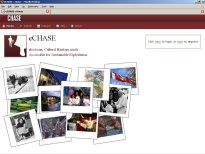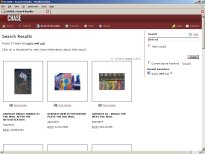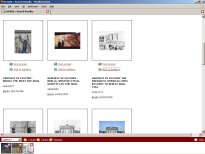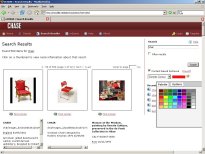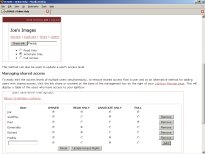
Welcome to the home of OpenMKS
What is OpenMKS?
OpenMKS is a tool for searching and navigating multimedia collections of images, video, 3D models and textual descriptions.
OpenMKS allows you to semantically integrate content from various sources and then expose the result using standards so it can be explored by users through their web browsers or by other software applications over the Web.
Our guiding principle is that you shouldn't need to restructure or re-catalogue all your multimedia collections when you want to combine them into one source of information or make them accessible for other people to use in new ways. Instead, we use semantic mapping techniques to relate different legacy data structures and descriptions to common standards such as the CIDOC CRM (see below for more about this).
It's this approach to semantic mapping and integration that allows new paths and links to be created through diverse collections of multimedia content, which in turn allows content users to ask all those questions that are hard to answer using conventional content management or search and retrieval systems.
OpenMKS is open source and is built using freely available off-the-shelf software components. OpenMKS is available to download and use from Source Forge as open source under the LGPL license.
Where did OpenMKS come from?
OpenMKS is developed by the IT Innovation Centre and started life in the in the European Commision funded Sculpteur project where it was used as a platform for cross-collection search and retrieval for images and 3D models from museums and galleries across Europe. Currently, OpenMKS is being further developed in the European Commission eCHASE project, where it is used for semantic integration of multimedia collections from a range of European archives and libraries so their content can be made accessible and usable in applications that include education and publishing. There's more information on these projects below.
OpenMKS certainly has it's roots in cultural heritage and the creative industries, but it's use is by no means restricted to these domains. The approach and standards we've used in OpenMKS should be equally applicable to other domains that use collections of multimedia content.
What's coming up next?
The software developed in Sculpteur and eCHASE has undergone research and development for over 5 years, but not all of this work has made it into the current OpenMKS release by a long shot. In fact, the version currently available for download is only a small part of what we have to offer and was only realy released on SourceForge so we could familiarise ourselves with the process and get a very early indication of whether people would be interested in it!
Thankfully, it appears that many people are interested in what we are doing, so we are now putting together a much more substantial release which will be available at the end of November. The documentation on these pages describes the upcoming release and includes screenshots of it being used in the eCHASE project, so you should get a good idea of what's coming here soon.
The new version of OpenMKS will include: inbuilt support for the CRM Core; lightbox management facilities where lightboxes can be shared in a controlled way, including the ability to allow other people to add, remove or annotate the content; building of advanced searches using interactive filtering; and integration with mSpace for exploring and browsing large collections.
Can I download it?
We would be very happy for you to download and try out the initial release of OpenMKS, but to be honest we suggest that you wait for the new version so you can take advantage of the much wider range of features it offers.
What are the main benefits of OpenMKS?
OpenMKS allows multimedia content to be taken from multiple sources and semantically integrated and exposed in an interoperable way for use in a variety of applications.
OpenMKS combines several different search modalities into one user interface including: targeted search and retrieval using authorities and free text searching in the OpenMKS web application; exploration and navigation by integrating with mSpace; and content-based retrieval (coming soon), which builds on technology developed by ECS to allow you to 'find things which look like this' as a creative way to explore large image collections.
OpenMKS allows users to select, aggregate, annotate and share groups of media items using one or more lightboxes. This supports collaborative scenarios that involve content sharing in an end-user applications, e.g. teaching or publishing.
Can I see it in action?
The screen shots below show OpenMKS as used in the eCHASE project.
How do I use it?
Firstly, you import the metadata describing one or more multimedia collections into the OpenMKS database. You can structure the metadada either according to the CRM Core schema already supported by OpenMKS, or you can use a schema of your choice. Next, you configure OpenMKS to describe what parts of the metadata should be exposed to OpenMKS users, e.g. which attributes you want them to be able to search on. If you are using the CRM Core schema then you are now pretty much ready to go, otherwise you'll also need to configure the Web user interface layer to present your content in the way you want, e.g. by adjusting the look and feel. The media, e.g. images or video, that goes with the metadata can either be served up through the OpenMKS webserver, or you can put it on some other web server of your choice. Starting up OpenMKS then makes the content Web accessible, both through the Web-based user interface and also through a set of Web Services that other applications can access if you need them to.
What standards are used in OpenMKS?
We make extensive use of standards for achieving interoperability. The CIDOC Conceptual Reference Model (CRM) forms the basis of modelling the 'who', 'why', 'what', 'where' and 'when' of content in the application domain. The Z39.50 Search and Retrieve Web Service (SRW) specification is used for accessing multimedia collections structured in this way. An advanced web interface then allows searching and navigating though interactive query building and refinement, exploration by finding related items, and the collection, annotation, sharing, and export of interesting content using light boxes. We make extensive use of XML for structuring data and Web Service standards for exposing content in a machine readable form over the Web.
Sculpteur and eCHASE
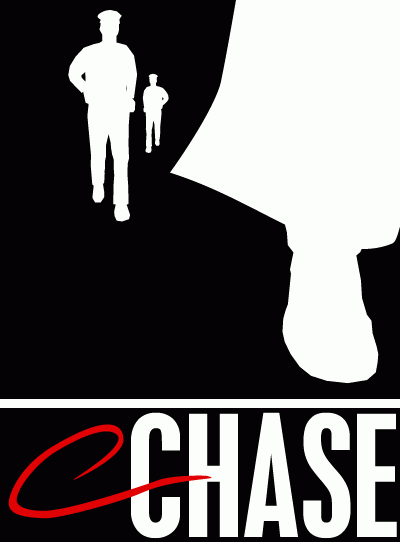
|
eCHASE (www.echase.org) is investigating business models for public-private partnerships between cultural heritage content holders (museums, libraries, archives) and content users according to the needs, prospects, rights and usage of different user-groups. Partners include DeAgostini, Getty Images, and Alinari as well as a range of technology suppliers. OpenMKS provides part of the software platform for eCHASE which allows multimedia content from a wide range of organisations to be semantically integrated and easily used by professionals in education and publishing. |

|
Sculpteur (www.sculpteurweb.org) investigated how digital collections from the Victoria and Albert Museum and the National Gallery in London, the Uffizi Gallery in Italy, the Centre de Recherche et de Restauration des Musees de France could be searched and shared. ECS applied a combination of knowledge engineering, content-based analysis and interoperable digital library technology to allow curators, conservators, and creative professionals to easily find content within multiple distributed collections. |
Further information
For further information on OpenMKS please contact: info@it-innovation.soton.ac.uk
